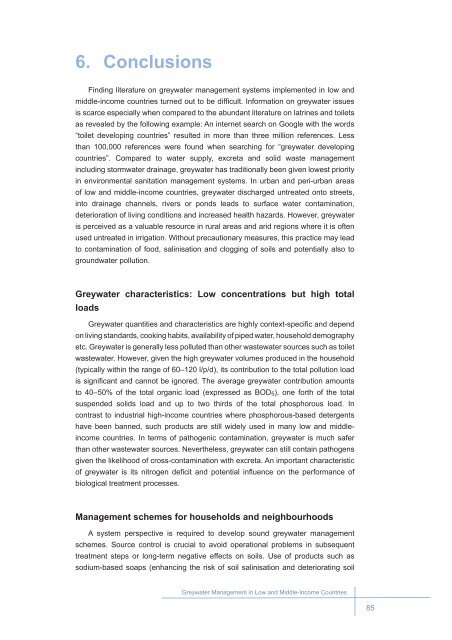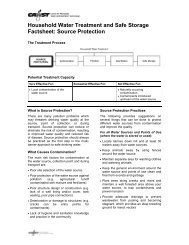Greywater Management in Low and Middle-Income Countries - SSWM
Greywater Management in Low and Middle-Income Countries - SSWM
Greywater Management in Low and Middle-Income Countries - SSWM
You also want an ePaper? Increase the reach of your titles
YUMPU automatically turns print PDFs into web optimized ePapers that Google loves.
6.<br />
<br />
F<strong>in</strong>d<strong>in</strong>g literature on greywater management systems implemented <strong>in</strong> low <strong>and</strong><br />
<br />
is scarce especially when compared to the abundant literature on latr<strong>in</strong>es <strong>and</strong> toilets<br />
as revealed by the follow<strong>in</strong>g example: An <strong>in</strong>ternet search on Google with the words<br />
<br />
<br />
countries”. Compared to water supply, excreta <strong>and</strong> solid waste management<br />
<strong>in</strong>clud<strong>in</strong>g stormwater dra<strong>in</strong>age, greywater has traditionally been given lowest priority<br />
<strong>in</strong> environmental sanitation management systems. In urban <strong>and</strong> peri-urban areas<br />
of low <strong>and</strong> middle-<strong>in</strong>come countries, greywater discharged untreated onto streets,<br />
<strong>in</strong>to dra<strong>in</strong>age channels, rivers or ponds leads to surface water contam<strong>in</strong>ation,<br />
deterioration of liv<strong>in</strong>g conditions <strong>and</strong> <strong>in</strong>creased health hazards. However, greywater<br />
is perceived as a valuable resource <strong>in</strong> rural areas <strong>and</strong> arid regions where it is often<br />
used untreated <strong>in</strong> irrigation. Without precautionary measures, this practice may lead<br />
to contam<strong>in</strong>ation of food, sal<strong>in</strong>isation <strong>and</strong> clogg<strong>in</strong>g of soils <strong>and</strong> potentially also to<br />
groundwater pollution.<br />
<br />
loads<br />
<br />
on liv<strong>in</strong>g st<strong>and</strong>ards, cook<strong>in</strong>g habits, availability of piped water, household demography<br />
etc. <strong>Greywater</strong> is generally less polluted than other wastewater sources such as toilet<br />
wastewater. However, given the high greywater volumes produced <strong>in</strong> the household<br />
(typically with<strong>in</strong> the range of 60–120 l/p/d), its contribution to the total pollution load<br />
<br />
to 40–50% of the total organic load (expressed as BOD 5), one forth of the total<br />
suspended solids load <strong>and</strong> up to two thirds of the total phosphorous load. In<br />
contrast to <strong>in</strong>dustrial high-<strong>in</strong>come countries where phosphorous-based detergents<br />
have been banned, such products are still widely used <strong>in</strong> many low <strong>and</strong> middle<strong>in</strong>come<br />
countries. In terms of pathogenic contam<strong>in</strong>ation, greywater is much safer<br />
than other wastewater sources. Nevertheless, greywater can still conta<strong>in</strong> pathogens<br />
given the likelihood of cross-contam<strong>in</strong>ation with excreta. An important characteristic<br />
<br />
biological treatment processes.<br />
<br />
A system perspective is required to develop sound greywater management<br />
schemes. Source control is crucial to avoid operational problems <strong>in</strong> subsequent<br />
treatment steps or long-term negative effects on soils. Use of products such as<br />
sodium-based soaps (enhanc<strong>in</strong>g the risk of soil sal<strong>in</strong>isation <strong>and</strong> deteriorat<strong>in</strong>g soil<br />
<strong>Greywater</strong> <strong>Management</strong> <strong>in</strong> <strong>Low</strong> <strong>and</strong> <strong>Middle</strong>-<strong>Income</strong> <strong>Countries</strong><br />
85
















